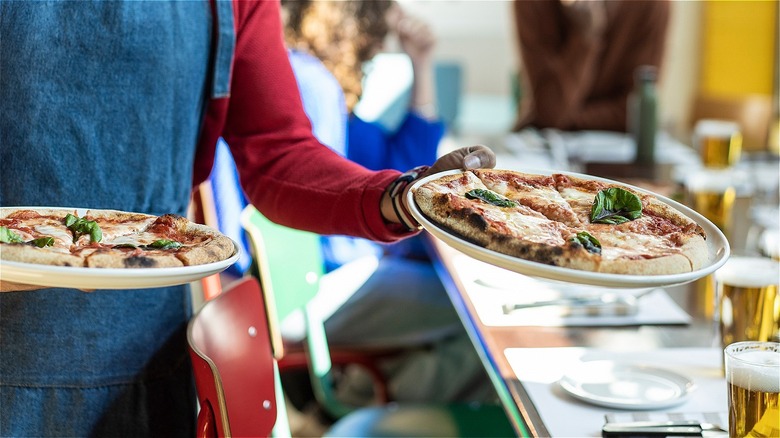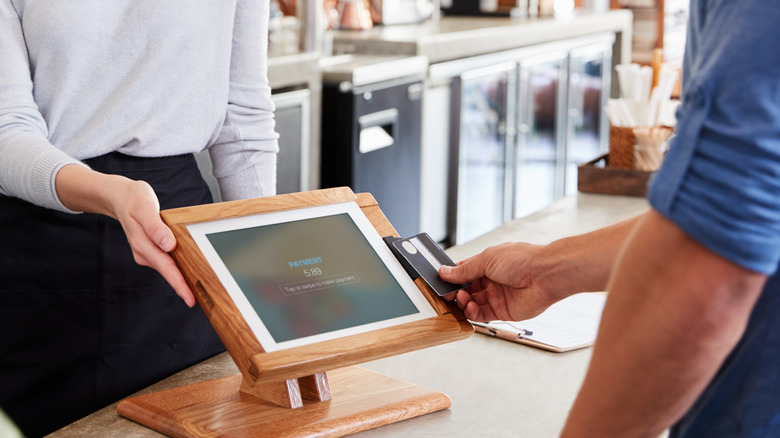Why Tipping 25% May Be The New Norm For Restaurants
The restaurant industry was hit hard during the pandemic. The notoriously challenging business, which historically has a failure rate of 60% during the first year and about 80% by the fifth year, saw 17% of restaurants in the U.S. permanently close in 2020 due to the pandemic, per CNBC.
Almost two million people in the U.S. make a living in the food industry, with an average age of employees 39 years old, per Zippia. Since 2009, the federal minimum wage for hourly workers has been stuck at $7.25, with a dozen states adjusting that number in 2023 to combat inflation, raising their state's minimum wage to $15 an hour (per Paycor). While the long overdue increase helps some in the food industry, restaurant workers are compensated less and rely on tips to make up the deficit. The average hourly rate for servers is between $9-$11 per hour. But according to the Department of Labor, the minimum rate for tipped employees sits at a paltry $2.13 per hour in several states.
In 2015, chefs like Tom Colicchio and Danny Meyer began taking more control of their server's compensation by eliminating tipping. In an interview with CNBC, Colicchio explains the injustice servers face being at the mercy of customer tips, especially in light of a study by Cornell University uncovering that "the amount of money left in a tip has very little to do with service, it has more to do with your accent, your race or your gender."
Gratuity included
Tom Colicchio mirrored the average tip in his Crafted Hospitality restaurant group to pay his servers more and raised prices by 20%, passing the money onto his staff. He removed the gratuity line from the bill, writing, "Hospitality is free! Gratuity is optional," per CNBC.
While service industry workers were our unsung heroes during the beginning of the pandemic, a 2022 survey by YouGov Plc found that only 73% of Americans are consistently tipping their waiter when dining out. That's fewer tips than before the pandemic when the average was 77%. Factors such as age, gender, and annual income influence who tips, with 87% of baby boomers (ages 58-76) consistently tipping, compared to only 52% of Gen Zers (ages 18-25).
So how much should you tip? Credit Cards found that the more money you make influences how generous the tip will be. Customers with an annual income of less than $50,000 tip on average 19% of the bill, while those who make between $50,000 and $79,999 tip 21%. 22% of the bill is left for servers by customers who make between $80,000 and $99,999 annually and a generous 26% by patrons with incomes of over $100,000. With so much uncertainty, retaining staff has been challenging as the industry tries to compensate for revenue lost over the past few years. According to CNBC, "workers are hesitant to return to service jobs that offer few benefits and low pay," leading to a shortage in the industry.
Preset tip suggestions
Since 2020, contactless and digital tips have become the norm, and the tipping culture has bled into service jobs that traditionally weren't expected to receive a gratuity. Baristas and fast food restaurant employees, who may have had a tipping cup by the register in the past, now present you with predetermined tipping options ranging from 15% to 25% when you pay with digital services like Block, formerly known as Square (per CNBC).
While 20% is still the average tip, the pandemic has brought a new awareness to the necessity of tipping our hourly employees. Eric Plam, the founder of the San Francisco-based start-up Uptip, which aims to facilitate cashless tipping, says, "People in the service industry are earning minimum or less than minimum wage; tips are absolutely critical. It's a core part of their compensation."
After six months, Tom Colicchio's no-tipping policy failed, forcing the chef to reverse his tipping rule. According to the NY Post, customers, particularly older ones, complained, wanting to compensate servers based on their experience. Until the minimum wage for all employees matches the cost of living, it's essential to understand that the assumption that patrons will tip their servers is built into their salary. Keep in mind the average annual wage for servers is $22,169, and if you live in the South, your waiter could be making as little as $2.13 per hour (per Salary).


